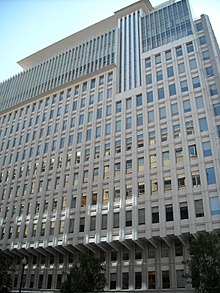World Bank Group
Group making loans to developing countries / From Wikipedia, the free encyclopedia
Dear Wikiwand AI, let's keep it short by simply answering these key questions:
Can you list the top facts and stats about World Bank Group?
Summarize this article for a 10 years old
The World Bank Group (WBG) is a family of five international organizations that make leveraged loans to developing countries. It is the largest and best-known development bank in the world and an observer at the United Nations Development Group.[6] The bank is headquartered in Washington, D.C., in the United States. It provided around $98.83 billion in loans and assistance to "developing" and transition countries in the 2021 fiscal year.[7] The bank's stated mission is to achieve the twin goals of ending extreme poverty and building shared prosperity.[8] Total lending as of 2015 for the last 10 years through Development Policy Financing was approximately $117 billion.[9] Its five organizations are the International Bank for Reconstruction and Development (IBRD), the International Development Association (IDA), the International Finance Corporation (IFC), the Multilateral Investment Guarantee Agency (MIGA) and the International Centre for Settlement of Investment Disputes (ICSID). The first two are sometimes collectively referred to as the World Bank.
 The World Bank Group building (Washington, DC) | |
| Established | 4 July 1944; 79 years ago (1944-07-04) |
|---|---|
| Type | Intergovernmental organization |
| Legal status | Treaty |
| Purpose | Economic development, poverty elimination |
| Headquarters | 1818 H Street Northwest, Washington D.C., U.S.[1] |
Membership | 189 states (188 UN countries and Kosovo)[2] |
| Ajay Banga[3] | |
MD & CFO | Anshula Kant[4] |
Main organ | Board of Directors[5] |
Parent organization | |
| Website | worldbank.org |
The World Bank's (the IBRD's and IDA's) activities focus on developing countries, in fields such as human development (e.g. education, health), agriculture and rural development (e.g. irrigation and rural services), environmental protection (e.g. pollution reduction, establishing and enforcing regulations), infrastructure (e.g. roads, urban regeneration, and electricity), large industrial construction projects, and governance (e.g. anti-corruption, legal institutions development). The IBRD and IDA provide loans at preferential rates to member countries, as well as grants to the poorest countries. Loans or grants for specific projects are often linked to wider policy changes in the sector or the country's economy as a whole. For example, a loan to improve coastal environmental management may be linked to the development of new environmental institutions at national and local levels and the implementation of new regulations to limit pollution.[10]